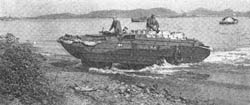A report on effective use of DUKWs at the Salerno landings from Combat Lessons, No. 3:
DUKWs at Salerno Report of a Quartermaster Truck Battalion (DUKW), Italy: The DUKWs (amphibious 2½-ton trucks) again proved of immense value at Salerno, supplies and equipment being handled over the beaches at a far greater rate than had been expected. The following points regarding their use should be borne in mind when planning for their use:
1. DUKWs must not be used for long trips inland.
2. Relief drivers and crews must be provided.
3. Definite steps must be taken to prevent overloading. Overloading at Salerno resulted in some being lost by sinking. One method of avoiding this would be to develop standard loads, particularly for ammunition. The load should not exceed 3 tons.
4. Ships to be unloaded should be moved inshore as close as possible, and should take position approximately opposite the beach landing point in order to reduce the turn-around. Unnecessary water travel means unnecessary delay in the discharge of cargo and increases the problem of maintenance.
5. A rigging crew from the DUKW unit should go aboard the vessel prior to unloading and rig the ship with necessary lines and hooks.
6. A great saving in time and labor can be effected if cargo nets are equipped with base plates shaped to fit the cargo space of the DUKW. Where cargo nets are not carried ashore by the DUKW, pallet loads can be used to expedite the discharge of cargo.
7. If possible each DUKW should carry only one type of cargo to avoid wasting time unloading at beach dumps.










